
Health 'Insurance' at Sea: 1 2 3 4 5 6 7 8 9 10 11 12 13 Next>>
Health 'Insurance' at Sea During the Golden Age of Piracy, Page 11
Long-Term Health Care - The Navy's Chatham Chest
The Chatham Chest was originally a charity fund created for the benefit of wounded Navy sailors. It was named for the location where payments into the fund were originally made: Hill-house in Chatham. It was founded by

Charles Howard of Effingham (1602)
Lord Howard of Effingham, Sir Francis Drake and Sir John Hawkins after the destruction of the Spanish Armada in 1588 "for the relief of the wounded and superannuated English Mariners."1 Most of the credit for its creation belong to the efforts of Lord Howard, who explained to Sir Francis Walsingham in 1588 that "England's soldiers needed to be treated decently so that others would be willing to serve."2
When founded, the Chest had no connection to the government, because it was funded by voluntary deductions. The independent status of the Chatham Chest was not to last; by order of the king deductions were made compulsory for all Navy sailors excepting officers, who were not entitled to its benefits at that time.3 Although its roots were in the late 16th century, historian Geoffrey L. Hudson notes that it only "became significant only after the three Dutch wars of 1652-4, 1665-7, and 1672-74"4, when a flood of disabled soldiers appeared.
A variety of factors contributed to the Chatham Chest frequently being on the brink of financial ruin. The large number of men leaving naval service at the end of the various wars combined with the surfeit of disabled men requiring assistance led to constant under funding. In addition, various cases of late payments by those assigned to collect the money from the sailors and indiscriminate borrowing from the Chest took their toll on its balance. Eventually, "the Government felt obliged to assume financial responsibility when the income was no longer sufficient to meet outgo"5, providing payments into the Chest beginning in the late 17th century following England's various wars.
The actual disbursement of funds from the Chest were overseen by Governors, which consisted of two masters of attendance, the first shipwright of Chatham, two boatswains, two gunners and two pursers of first- and second-rate ships.
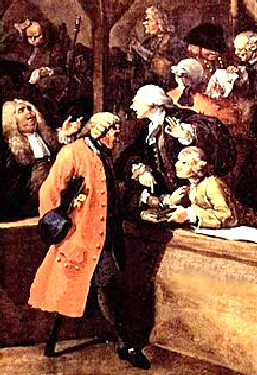
Artist: William Hogarth (1744-5)
Each year the former Governors would choose the next year's Governors who would then chose two Commissioners of the Navy to supervise them.6
To receive payment from the Chatham Chest for a disabling wound, a sailor had to get "a certificate signed by the captain, lieutenant, master, surgeon, and warrant officers belonging to the ship where he received his wound."7 He then attended the Governors' meeting - they met monthly during times of war and quarterly during times of peace. The wounded man was examined by two Surgeons appointed for this purpose "and the truth and validity of the certificate were scrutinised."8 If the Governors approved the sailor's disability, the surgeons certified the amount.
The Governors of the Chest operated independently of the Navy. This sometimes created friction over particular awards. In 1673, the Navy Commissioners wrote to the Governors questioning the amount of money awarded to a James Foucard. The Governors explained that their "allowance of all pensions and reliefs is grounded upon the judgement of two surgeons, who view the men in our presence and certify their opinions in writing under their hands, and we cannot believe them guilty of any partiality in their reports, because the lessening a poor man's reward would add nothing to theirs."9
Since the Chest was created to care for permanently disabled sailors, pensions were granted for life. This was particularly true when the sailor could not work because of his disability, although this was subject to review.10 Men with nonpermanent wounds were usually to be supported by the Sick and Hurt Commission, highlighting the difference between long-term and intermediate health care. "It was not permissible for anyone to benefit from both sources
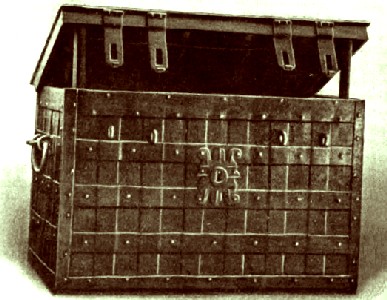
The Chatham Chest, From "Social England," Vol. III, Sect II, p. 645
but this did occasionally happen, because those responsible for administering the two organisations did not regularly compare the names of beneficiaries."11
Interestingly, an actual, physical Chatham Chest, was built to hold the funds in 1625.12 It had five locks on it, with the five keys to the locks being "held by, respectively, a principal Navy officer, a Master Attendant, a Master Shipwright, a Boatswain and a Purser. A new key-holder had to be appointed annually for each key."13 The chest itself resides at Chatham Dockyard Museum where it is apparently closely guarded against photographers. (I did find this image of it in an out-of-copyright book. However, you can see much better photos of it via this link.)
The Chatham Chest has a long and storied history and there are a variety of interesting elements associated it which have only briefly been mentioned here. Since they highlight some of the benefits and problems associated with operating a long-term health care program for sailors, let's look at some of them in detail.
1 Francis Sellon White, A History of Inventions and Discoveries, 1827, p. 435; 2 Geoffrey L. Hudson, “Disabled Veterans and the State in Early Modern England”, Disabled Veterans in History, David A. Gerber, ed., 2015, p. 119; 3 Geoffrey L. Hudson, "The Relief of English Disabled Ex-Sailors, c. 1590-1680", The Social History of English Seamen, 1485-1649, p. 232; 4 Hudson, “Disabled Veterans and the State", p. 122; 5 C.G. Lewin, Pensions and Insurance Before 1800 A Social History, 2003, p. 239; 6 Lewin, p. 231;,7,8 Lewin, p. 218; 9 Lewin, p. 230; 10 Lewin, p. 216; 11 Lewin, p. 226; 12 "Chatham Chest", Royal Museums Greenwich, www.collections.rmg.co.uk, gathered 3/14/16; 13 Lewin, p. 216-8;
Long-Term Health Care - Financing The Navy's Chatham Chest
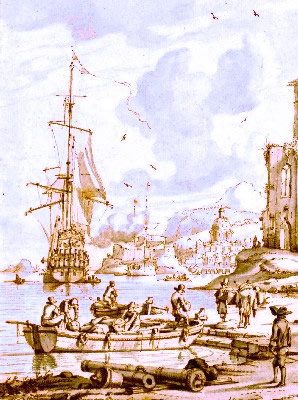
Artist: Abraham Storck
Ships and Characters at the Entrance of a Port (1674)
The Chatham Chest began as a charity fund, being financed by those who could benefit from it. The monthly donation men made to the chest varied by their station (and pay). Regular sailors donated 6 pence, trainees (or 'grommets') paid 4 pence and ship's boys gave 3 pence. This worked out to be a 5% contribution rate, "which is found in many pension funds today."1 Even though it was considered independent of the Navy, the pay of seamen was increased from 6s. 8d. to 10s. 0d. per month shortly before the men agreed to have money deducted from their pay for the Chatham Chest.2
The amount paid into the chest by the sailors remained constant. At a meeting of a 'Commission of inspecting the Chest', Samuel Pepys noted that while the sailors had agreed to a payment of 6 pence in '1588 or 1590', it was "according to their wages... which was then but 10s. [and] which is now 24s."5 The Commission took no action on this information, so the deduction remained the same all the way through the end of the golden age of piracy.
Purchased land provided another source of income. Beginning in the early 17th century, surplus money from the Chest was used to make property investments. The rents from this land were able to inject supplemental funds into the charity.3 By 1688, the land rentals were providing over £400 per year to the Chest.4
After the Spanish War ended in 1660, the number of permanently injured from it and the preceding First Dutch War had increased to the point where the finances of the Chest were ready to collapse. This situation was exacerbated by a loss in revenue as sailors who were
paying into the chest monthly were 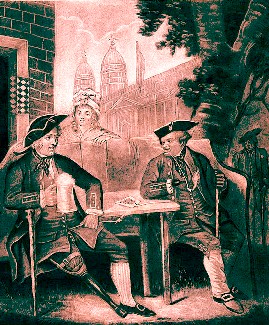
Two Greenwich Pensioners
Sitting in the Garden of a
Tavern, Wellcome Collection (1791)
released from naval service. A two part plan was devised to save it. The first part of the plan involved charging the men in ships being paid off an extra 6 pence a month, which the Navy claimed the men were willing to do 'for and towards the easement' of the charges against the Chest. The second part of the plan involved using the 'extra chest' money for "the buying out of such pensioners as are willing and desirous to sell their pensions, and to no other end: and that Sir William Batten [Surveyor of the Navy] be desired to keep the money in his hand for that purpose"6.
This was only a one-time solution to the chronic bust-and-boom financing problem, however. As time went on, additional funding sources were channeled into the Chatham Chest. At some time before 1672, it became custom to put the money that the navy men paid for their ship's chaplain (4 pence a month) and/or surgeon (2 pence a month) into the Chatham Chest fund when their ship didn't have one or both of these officers.7
Naval fines were also put into the chest. The Navy Board was given the ability to impose fines for misbehavior in 1664. As a result, rules were created such as: "those that shall give themselves up to Cursing, Execrations, Drunkenness, Uncleanness, or other scandalous actions in derogation of God's Honour, and corruption of good manners, fynes and Imprisonment or such other punishment may be inflicted on them, by a Court Marshall, which is now reduced to the forfeiture of one day's pay"8. This money was stopped from the guilty party's pay and directed to the Chatham Chest.9

Artist: Nicolas Bernard Lépicié (1775)
Officers were also fined. As early as 1669, a Court Martial fine of £17 5s. 0d was taken from a captain's wages and put into the Chest. In 1702, no less than privateer William Dampier was found guilty of "cruelty to his lieutenant and 'fined all his pay to the chest at Chatham'."10
Chest funds could also be conserved by limiting the payments made to pensioners. Although this could not be done willy-nilly without creating a public outcry, the building of the Greenwich hospital provided an opportunity. In 1712, about 7 years after the opening of the hospital, it was "ordered that pensioners admitted into the Royal Hospital at Greenwich should be immediately struck off their pensions from the Chest."11
The presence of the infirmary proved to be a double-edged sword for the Chest, however. Due to the added expense of the new Greenwich Hospital, it was decided in 1709 that fines paid by officers and seamen should go towards the hospital rather than the Chest. The Chatham Chest Governors protested strongly.12
None of these extra revenue streams completely solved the problem (which was further complicated by deceitful practices on behalf of those who were trusted to collect and deposit the funds as we shall see.) In 1673 the Governors of the Chest wrote to the Navy Commissioners:
Permit us to acquaint your Honours with the unhappy prospect we have of the ruin of the Chest, unless supported by your timely and favourable interposition on behalf of the poor, for even during the War, our income bears no proportion with our issues [outgo], and it is easy to foresee what will become of us when that income shall cease, and yet the charge contracted in the war remain. We do but mention this to your Honours now, but we fear our necessity will very suddenly bring us as humble supplicants before you to mediate with the King for some relief, and we most heartily wish that some expedient might be found to support the Chest without being burdensome to his Majesty.13
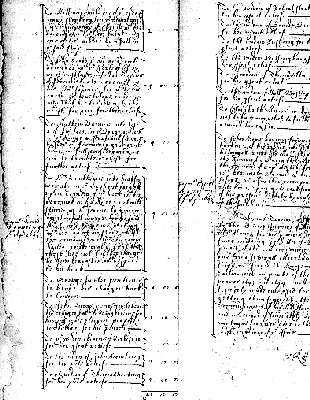
Chatham Chest Accounts 1645/6, From the Wellcome Collection
From this point forward, the government appears to have supported expenses of the chest beyond those of its revenue streams on a "pay-as-you-go basis, although these payments by the Government were perhaps at first regarded as merely loans to the Chest."14 This discrepancy grew rapidly, from about £5,000 a year in the 1670s to £9,000 in 1694.
In May of 1688 (14 years after the end of the Third Dutch War), there were 650 pensioners still receiving money from the Chest in the amount of £5,694 7s. 7d. The Chest's income that year was about £1,700 with the shortfall being provided "'as it hath formerly been accustomed' by the King."15 Near the end of William's War in 1697, the account book listed over 1800 pensioners. "In 1701 the Government owed the Chest nearly £28,000, 'which would enable them to clear the pensions due to near 2,000 cripples who were upwards of two years in arrear'."16 By 1709, the number had grown to 2,791 pensioners.
The crown's support for the Chatham Chest seems to have been formalized for the first time in 1709, when the First Lord of the Treasury Sidney Godolphin wrote a letter to Queen Anne explaining "that the State had an obligation to meet the shortfall of expenditure over income, though in practice this seems to have happened since about 1673."17
1,2 C.G. Lewin, Pensions and Insurance Before 1800 A Social History, 2003, p. 216; 3 Geoffrey L. Hudson, "The Relief of English Disabled Ex-Sailors, c. 1590-1680", The Social History of English Seamen, 1485-1649, p. 232; 4 Lewin, p. 231; 5 Samuel Pepys, The Diary of Samuel Pepys, November 16, 1662 entry; 6 Lewin, p. 224; 7 Lewin, p. 235; 8 Charles Molloy, De Jure Maritimo Et Navali Or a Treatise of Affaires Maritime and of Commerce, 1676, p. 125; 9 John J. Keevil, Medicine and the Navy 1200-1900: Volume II – 1640-1714, p. 135; 10 Lewin, p. 230; 11 Lewin, p. 233; 12 Lewin, p. 232; 13 Lewin, p. 229-30; 14 Lewin, p. 230; 15 Lewin, p. 230; 16 Lewin, p. 232; 17 Lewin, p. 233
Long-Term Health Care - Fleecing The Navy's Chatham Chest
"'This contribution [to the Chatham Chest] hath ever since been paid, but so many hands fleeced the chest, either by detaining that which they should have paid as Treasurers and accountants or by borrowing thence under colour of repayment; which they have never yet done..." (Thomas Norris, Former Shipwright, cited in C.G. Lewin, Pensions and Insurance Before 1800 A Social History, 2003, p. 219)
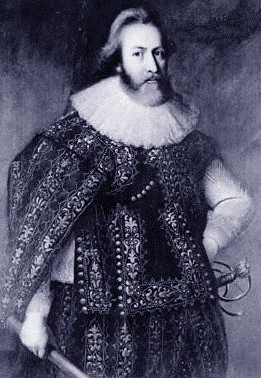
Sir Robert Mansell
While accounts had been regularly kept of the payments into the chest, they became irregular when Sir Robert Mansell became Treasurer of Marine Causes. Mansell claimed to have given money from the chest 'to men who had needed it, but there no record of to whom or when the money was given has been found. "Successive Treasurers followed this bad example and retained moneys due to the Chest. For example, Sir Sackville Crowe, who was Treasurer from 1627 to 1629, appropriated £3,000 and the money was still owing in 1644."1
As a result of such behavior, it was announced at a Council meeting in 1637, ''his Majesty doth expressly command that the sixpence due out of every man's monthly pay be collected after the usual manner and presently [immediately] paid to the Governors of the Chest, upon pretence of his Majesty's service, or upon any other colour or cause whatsoever"2. The Navy Treasurer was required to pay all contributions to the Clerk of Chest "within one month of their deduction from pay."3
This was not the end of men finagling the finances of the Chest, however. In 1662, Pepys prompted the appointment of a Commission to examine the affairs of the Chest. On behalf of this Commission Pepys reviewed the accounts of Commissioner Peter Pett, nothing that "I did see things did not please me; as his allowing himself [£]1300 for one year’s looking to the business of the Chest, and 150l. per annum for the rest of the years."4
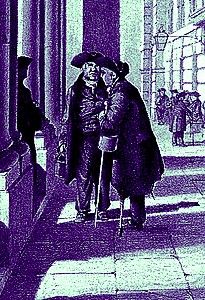
Artist: Samuel Rayner
Naval Pensioners, Wellcome Collection
Money from the Chatham Chest were also often used to pay for dinners for the Governor's meetings. Payments were sometimes paid to surgeons for curing men "thereby presumably saving the Chest from having to pay benefits."5
You may recall that Surveyor of the Navy Sir William Batten was charged with keeping the money from the 'Extra Chest' "in his hand" to pay off men who were willing to have their annual pensions bought off for a lump sum in 1661 after the Spanish War. When Batten died in 1667, Samuel Pepys went over the records of the 'Extra Chest' and discovered that Batten had kept £500 for himself, "in consideration of his pains taken in receiving the Extra Chest money and paying it out again to pensioners and taking their receipts for the same, the business of the Extra Chest being first set on foot by him and countenanced and carried on by his continued care and direction for the benefit of the Chest"6.
Several similar fleecings were discovered, which, while extraordinarily unfortunate, should not be entirely surprising given that number of men who were charged with handling this money in the service of the government. Several, like Batten, seem to have felt that payments to themselves was their due. (Some things never change, do they?)
1 C.G. Lewin, Pensions and Insurance Before 1800 A Social History, 2003, p. 220; 2 Lewin, p. 220-1; 3 Lewin, p. 221; 5 Samuel Pepys, The Diary of Samuel Pepys, December 3, 1662 entry; 4 Lewin, p. 221-2; 6 Lewin, p. 228

